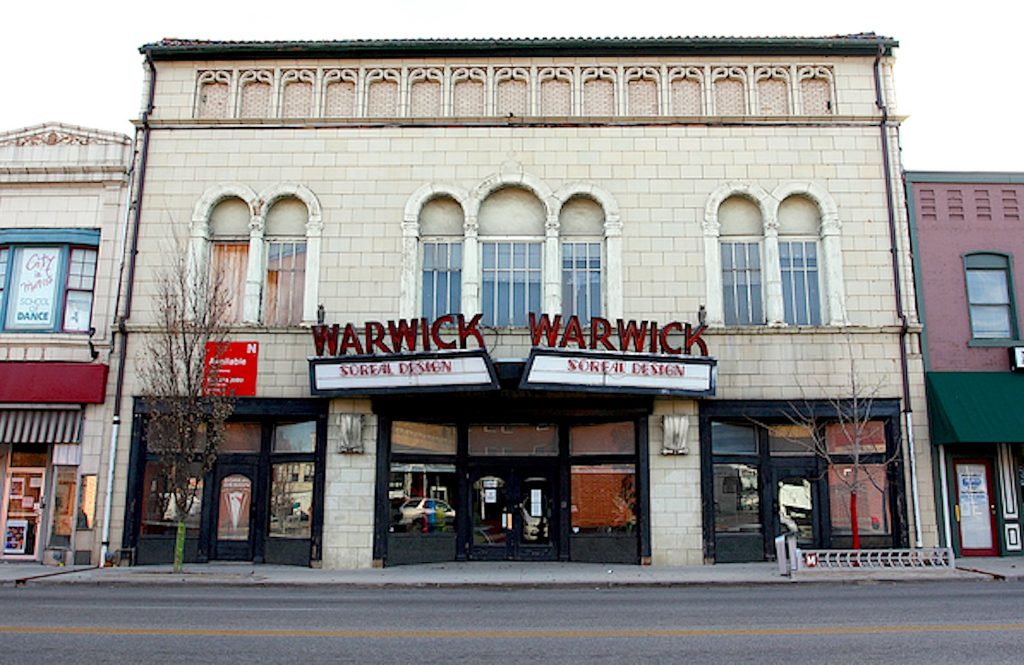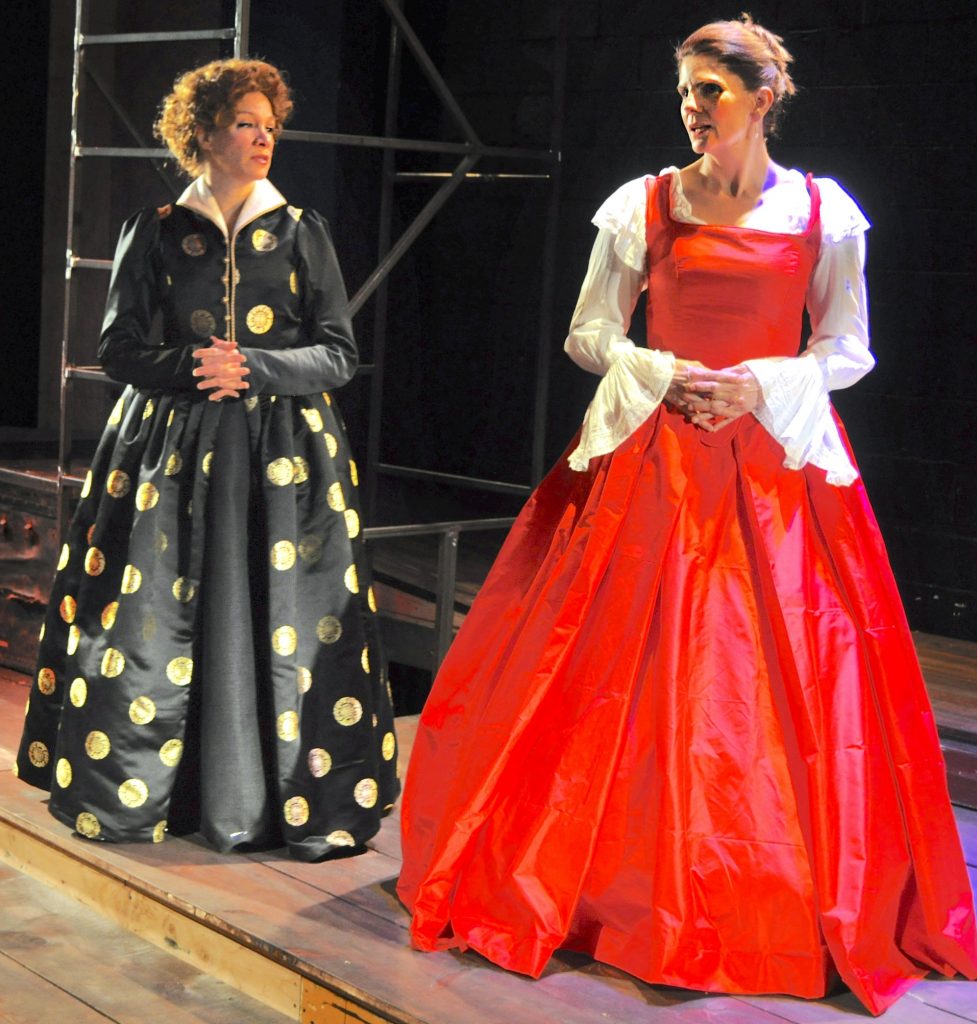Karen Paisley and the board of directors of the Metropolitan Ensemble Theatre have an urgent message for Kansas City theatergoers: We’re still here.
Ten months after what appeared to be a devastating fire at the company’s home, the Warwick Theatre on South Main, this 20-year-old company has assiduously scrubbed, polished, demolished, salvaged.
Now, armed with fresh determination to save the astonishingly solid 112-year-old structure, the MET is almost ready to begin Phase 2 of the restoration: which will involve contractors rebuilding the three-story northeast corner in back and replacing electrical, plumbing, and HVAC systems that were damaged.
“We are not closed, we are simply rebuilding,” said Karen recently, as we toured the Westport-area theater the Boller Brothers built in 1912, observing the remarkable progress that the MET’s homegrown work force had made since the February 7th blaze. “There hasn’t been a day that we weren’t working. We are going to be back.”
Back in their own theater, that is — by late spring 2025, if all goes well, or early fall at the latest.
Moreover, Karen hastened to add: “We are still producing theater, on whatever scale we can, and that is important for people to know. We are not dead.”
Indeed, as we chatted in an upper gallery of the theater recently, two actors below us were preparing for the MET’s upcoming production of Mark St. Germain’s play Freud’s Last Session, which was to be performed the following week at Simpson House — one of several alternative venues the MET has used for performances during the reconstruction phase.
Was there ever a point at which it seemed just too overwhelming?

“Quitting was the most mundane option,” said Karen, who co-founded this pluckiest of companies in 2005 with her ex-husband, Robert Paisley. “Especially when winning is so important. When things got really hard, because it was taking so long, the determination of our crew and the support of the community lifted me back up again.”
It’s not just about a theater, it’s about what goes on inside. “The Warwick and the MET both exist for the good of the entire community,” Karen added. “How can we quit when it matters so much?”
Things looked bad at first, really bad. During the days after the fire, which broke out in the rear offices and storage areas in the early morning hours, initial inspections revealed a thick layer of soot, char, and ash over pretty much everything. The fire had evidently broken out as a result of solvent-soaked paper towels inadvertently left in a trash bin by a volunteer.

It destroyed most of the office space and costume shops. In the next several days, burglars smashed windows and doors and made off with furniture, sound equipment, props, tools, cameras, and anything else that wasn’t nailed down.
The theater space was largely unscathed by the fire itself, but the soot presented a major challenge. Nevertheless, the board of directors determined to save the 15,000-square-foot building. The Warwick is also used for non-MET-related productions and concerts, so its loss would impact a wide range of artists.
“Phase 1 was cleaning everything that was smoke-covered,” Karen said. “Which was every single surface of everything. It takes soap and more: We’ve become experts at how many different types of products there are, and what we can do with them.”
Insurance would help pay for part of the $1.2 million in estimated damages, but it was ultimately impossible to determine the dollar value of thousands of designer costumes, hats, shoes, and furniture set-pieces that were lost.
Within a few weeks, a handful of company members, cleaning professionals, and others started demolition, removal, and remediation. “We’ve been doing everything ourselves that we can,” Karen said. “Fire-restoration specialists coached us on what to do, because it was going to cost so much to hire people to do it.”
During the first days, electrical systems were down and the air hadn’t cleared. “It was pitch-dark in here, and the air was so foul that breathing was really hard,” Karen said.
But the team immediately discovered some things that were salvageable, giving them hope, and they set to work sorting wins from losses — a process that continues to this day.
“There were costumes I really wanted to get to,” she said — including, for example, some priceless gowns worn by Cheryl Weaver and Karen in a production of Mary Stuart. Thousands of other items were lost.
The good news was that the structural backbone of the original theater had stood firm.
“She is a heck of a building,” Karen said. “Nothing gave way. … And because the fire was it the back, the really historical part of the building was saved. This theater was built so well, with giant timbers that are stout. Those great big rafters are hard.”
The Boller Brothers built nearly 100 theaters in a dozen states, with a concentration in Kansas, Missouri, and Oklahoma. They include the Crown Uptown Theatre in Wichita, the Jayhawk in Topeka, the Wareham in Manhattan, the Missouri in St. Joseph, and the Granada Theatres in Lawrence and Emporia.
Among the local structures still standing are the Midland in downtown Kansas City, the Rio in Overland Park, the Granada in Kansas City, Kansas, and the Booth in Independence.
The Warwick, built in Colonial Revival style and listed on the National Registry of Historic Sites, originally seated 1,022 on two floors. It was refurbished after a 1927 fire and remained a movie theater until it closed in 1953.
For years afterward it was a furniture store, among other things, before being bought by the MET in 2015.
Located just north of the Country Club Plaza and directly on the future streetcar line, the Warwick is smack-dab in the middle of an up-and-coming part of Kansas City. All around it is renewal, in the form of new restaurants, retail, and condominiums.
“This neighborhood is really special,” Karen said, “and we need to remember that.”
There is no dollar value one can place on a historic structure. Its history is part of its magic. “There is a strange but special relationship that develops between theater artists and the space in which they perform,” said actor and retired theater teacher Todd Schnake, who chatted during a break in the downstairs rehearsal of Freud’s Last Session, in which he was playing C.S. Lewis.

Early television news reports looked grim, especially as they were taped primarily from the charred back end of the structure.
“Based on what I had seen on the news that day, it looked like it was all gone,” said actor Park Buckner, who was preparing for the role of Sigmund Freud in St. Germain’s play. “I was of course relieved to learn that the actual theater had been preserved.”
Having acted in the space before, Park said he loves the Warwick’s versatility and vibrancy.
“There’s a reason why churches and theaters are often constructed similarly,” he said, “because they are communal spaces where we come and share important things together. People have been gathering in this space for more than 100 years.”
If there is a Phase 3, it is the full-scale reopening of the Warwick as a space for theater, probably toward the end of 2025. Then the company can resume the restoration that was ongoing even before the fire.
Karen has managed to keep her courage through it all, thanks partly to a series of near-miracles — one in particular. When the fire struck, she was desperately looking for her beloved Poppy, a Great Pyrenees/Golden Retriever mix who had disappeared from her back yard a week before.
On the morning that Karen arrived to see flames shooting out of the Warwick, she got a call from someone who had apparently found her — wandering through a farm 43 miles from home. The resident sent a picture: Karen was sure it was Poppy.
“I doubt I could have survived all this without her,” she said of the pet’s reappearance, just hours after the fire. “This would have been an entirely different experience if that had not happened. She was heaven-sent.”
—By Paul Horsley
The MET’s next production is Book of Days by Pulitzer Prize-winning playwright Lanford Wilson, to be performed January 28th through February 2nd at a venue to be announced. For tickets and for information about other upcoming shows, go to metkc.org.
To reach Paul Horsley, performing arts editor, send an email to paul@kcindependent.com or find him on Facebook (paul.horsley.501) or Twitter/Instagram (@phorsleycritic).




